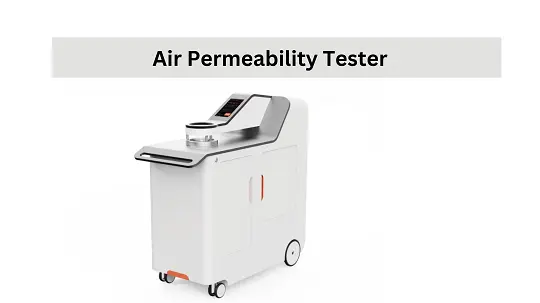How to Operate Air Permeability Tester?
Have you wondered how breathable your favorite sports jacket is? Or how well air flows through a surgical mask? The answer lies in a nifty device called an air permeability tester. This specialized equipment measures the resistance a material offers to air passage, providing valuable insights into its breathability, porosity, and overall quality. But how exactly do you operate this instrument? In this article, we explain on How to Operate an Air Permeability Tester.
Air permeability testing is a crucial procedure in the textile industry. It ensures the quality and functionality of materials. Understanding how to operate an air permeability tester is essential for accurate results and efficient testing processes.

What is an Air Permeability Tester?
Air permeability testing is the measurement of the flow of air through a material under specific conditions. It’s a fundamental method used to determine the breathability, porosity, and air resistance of various materials.
An air permeability tester, also known as a fabric breathability tester, is a scientific instrument designed to quantify the resistance a material offers to airflow. It typically employs a vacuum pump to draw air through a specific area of the test specimen at a predetermined pressure. By measuring the volume of air passing through the material within a set timeframe, the tester calculates the air permeability value.
Core Functionality:
Imagine a test chamber with a circular opening. You place your fabric sample over this opening, and the machine essentially acts like a giant vacuum cleaner, sucking air through the fabric at a controlled pressure. The faster air passes through, the higher the air permeability, indicating a more breathable material. Conversely, a lower air permeability value signifies a tighter weave or denser material that resists airflow.
Components of Air Permeability Tester
Air permeability testers consist of several components, including a test chamber, a pressure system, and a differential pressure gauge. The test chamber houses the material to be tested, while the pressure system controls the airflow. The differential pressure gauge measures the pressure difference across the material.
How Does an Air Permeability Tester Work?
The tester works based on the principle of airflow through a material under controlled conditions. When air is passed through the test material, the pressure drop across the material is measured, determining its air permeability.
Operating the Air Permeability Tester
Now that you’re prepped, let’s delve into the actual operation of the air permeability tester:
Power Up and System Check:
- Turn on the air permeability tester following the manufacturer’s instructions.
- The device might perform a self-check to verify proper functionality.
Sample Placement and Securing:
- Locate the test head and ensure it’s clean and free from debris.
- Carefully place your prepared sample over the test head opening, ensuring a flat and smooth surface.
- Depending on the tester model, you might have a clamping mechanism to secure the sample firmly in place.
Setting Test Parameters (Pressure, Units):
Most testers allow you to set the desired test pressure. This value typically ranges from 100 Pa (Pascal) to 5000 Pa, depending on the material and relevant standards. 2. You can also choose the unit of measurement for the test results. Common options include cubic centimeters per second (cm³/s), cubic meters per second (m³/s), or CFM (cubic feet per minute). Refer to the testing standard or your specific needs for unit selection.
Initiating the Test and Data Acquisition:
- Once the sample is secured and parameters are set, locate the start button on the tester. Initiating the test might involve pressing a button or activating a foot pedal (depending on the model).
- The tester will automatically draw air through the sample at the predetermined pressure for a set duration.
- Upon test completion, the instrument will display the calculated air permeability value on the screen in the chosen unit. Some testers allow data export for further analysis.
Examples:
Imagine you test a sample of athletic wear fabric and obtain an air permeability value of 200 cm³/s. This indicates good breathability, allowing for better moisture management during exercise. Conversely, a nonwoven fabric used for a surgical mask and surgical gown might have a value of 50 cm³/s, ensuring adequate air circulation while still offering filtration efficiency.
Calibrating the Air Permeability Tester
Calibrating the air permeability tester is crucial for accurate results. It involves adjusting the machine to ensure that it performs consistently and reliably. Calibration typically involves setting the correct pressure levels and verifying the accuracy of the differential pressure gauge.
Preparation Before Testing
Before conducting a test, it’s essential to set up the machine properly and ensure that testing conditions are suitable. This includes preparing the test chamber, ensuring a stable airflow, and verifying that the material is positioned correctly.
Conducting the Test
To conduct the test, place the sample material in the test chamber and start the airflow. The machine will measure the pressure drop across the material as air passes through it. The test usually runs for a specified duration, after which the results are recorded.
Interpreting the Results
Interpreting the results involves understanding the airflow data collected during the test. Lower pressure drops indicate higher air permeability, while higher pressure drops suggest lower permeability. These results provide valuable insights into the material’s breathability and porosity.
Conclusion
To know How to Operate an Air Permeability Tester? Mastering the operation of an air permeability tester is crucial for industries that rely on accurate measurements of material properties. From understanding the machine’s components to interpreting test results, proper operation ensures quality, efficiency, and regulatory compliance.
